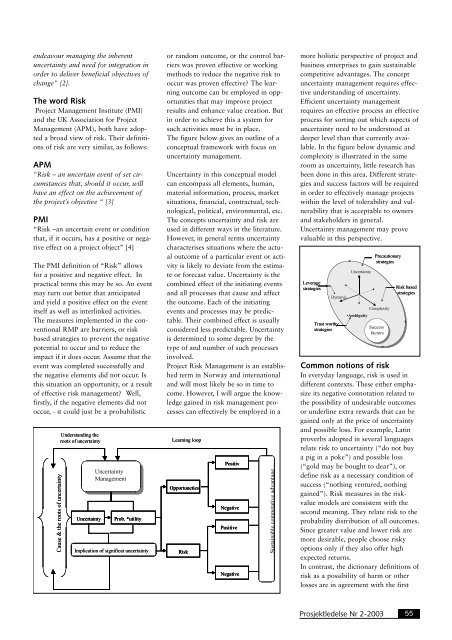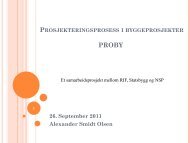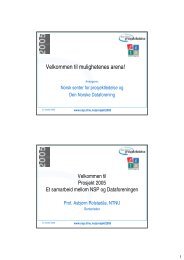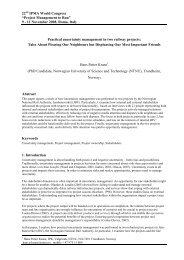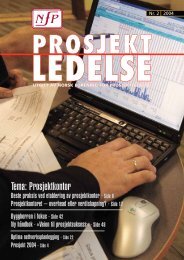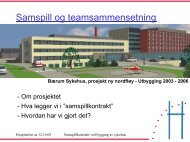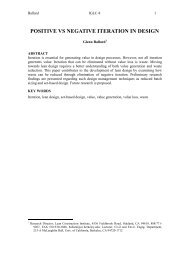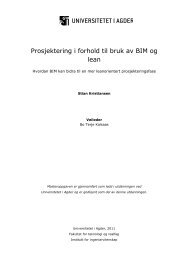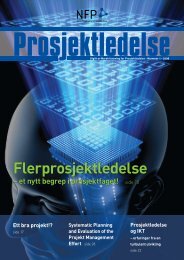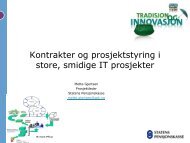Prosjektledelse, Nr. 2 - 2003 - Norsk senter for prosjektledelse - NTNU
Prosjektledelse, Nr. 2 - 2003 - Norsk senter for prosjektledelse - NTNU
Prosjektledelse, Nr. 2 - 2003 - Norsk senter for prosjektledelse - NTNU
You also want an ePaper? Increase the reach of your titles
YUMPU automatically turns print PDFs into web optimized ePapers that Google loves.
endeavour managing the inherent<br />
uncertainty and need <strong>for</strong> integration in<br />
order to deliver beneficial objectives of<br />
change” [2].<br />
The word Risk<br />
Project Management Institute (PMI)<br />
and the UK Association <strong>for</strong> Project<br />
Management (APM), both have adopted<br />
a broad view of risk. Their definitions<br />
of risk are very similar, as follows:<br />
APM<br />
“Risk – an uncertain event of set circumstances<br />
that, should it occur, will<br />
have an effect on the achievement of<br />
the project’s objective “ [3]<br />
PMI<br />
“Risk –an uncertain event or condition<br />
that, if it occurs, has a positive or negative<br />
effect on a project object” [4]<br />
The PMI definition of “Risk” allows<br />
<strong>for</strong> a positive and negative effect. In<br />
practical terms this may be so. An event<br />
may turn out better that anticipated<br />
and yield a positive effect on the event<br />
itself as well as interlinked activities.<br />
The measures implemented in the conventional<br />
RMP are barriers, or risk<br />
based strategies to prevent the negative<br />
potential to occur and to reduce the<br />
impact if it does occur. Assume that the<br />
event was completed successfully and<br />
the negative elements did not occur. Is<br />
this situation an opportunity, or a result<br />
of effective risk management Well,<br />
firstly, if the negative elements did not<br />
occur, - it could just be a probabilistic<br />
Cause & the roots of uncertainty<br />
Understanding the<br />
roots of uncertainty<br />
Uncertainty<br />
Uncertainty<br />
Management<br />
Prob. *utility<br />
Implication of significat uncertainty<br />
or random outcome, or the control barriers<br />
was proven effective or working<br />
methods to reduce the negative risk to<br />
occur was proven effective The learning<br />
outcome can be employed in opportunities<br />
that may improve project<br />
results and enhance value creation. But<br />
in order to achieve this a system <strong>for</strong><br />
such activities must be in place.<br />
The figure below gives an outline of a<br />
conceptual framework with focus on<br />
uncertainty management.<br />
Uncertainty in this conceptual model<br />
can encompass all elements, human,<br />
material in<strong>for</strong>mation, process, market<br />
situations, financial, contractual, technological,<br />
political, environmental, etc.<br />
The concepts uncertainty and risk are<br />
used in different ways in the literature.<br />
However, in general terms uncertainty<br />
characterises situations where the actual<br />
outcome of a particular event or activity<br />
is likely to deviate from the estimate<br />
or <strong>for</strong>ecast value. Uncertainty is the<br />
combined effect of the initiating events<br />
and all processes that cause and affect<br />
the outcome. Each of the initiating<br />
events and processes may be predictable.<br />
Their combined effect is usually<br />
considered less predictable. Uncertainty<br />
is determined to some degree by the<br />
type of and number of such processes<br />
involved.<br />
Project Risk Management is an established<br />
term in Norway and international<br />
and will most likely be so in time to<br />
come. However, I will argue the knowledge<br />
gained in risk management processes<br />
can effectively be employed in a<br />
Learning loop<br />
Opportuneties<br />
Risk<br />
Positiv<br />
Negative<br />
Positive<br />
Negative<br />
Sustainable competative advantage<br />
more holistic perspective of project and<br />
business enterprises to gain sustainable<br />
competitive advantages. The concept<br />
uncertainty management requires effective<br />
understanding of uncertainty.<br />
Efficient uncertainty management<br />
requires an effective process an effective<br />
process <strong>for</strong> sorting out which aspects of<br />
uncertainty need to be understood at<br />
deeper level than that currently available.<br />
In the figure below dynamic and<br />
complexity is illustrated in the same<br />
room as uncertainty, little research has<br />
been done in this area. Different strategies<br />
and success factors will be required<br />
in order to effectively manage projects<br />
within the level of tolerability and vulnerability<br />
that is acceptable to owners<br />
and stakeholders in general.<br />
Uncertainty management may prove<br />
valuable in this perspective.<br />
Leverage<br />
strategies<br />
Dynamic<br />
Trust worthy<br />
strategies<br />
Uncertainty<br />
•Ambiguity<br />
Precautionary<br />
strategies<br />
Complexity<br />
Success<br />
factors<br />
Risk based<br />
strategies<br />
Common notions of risk<br />
In everyday language, risk is used in<br />
different contexts. These either emphasize<br />
its negative connotation related to<br />
the possibility of undesirable outcomes<br />
or underline extra rewards that can be<br />
gained only at the price of uncertainty<br />
and possible loss. For example, Latin<br />
proverbs adopted in several languages<br />
relate risk to uncertainty (“do not buy<br />
a pig in a poke”) and possible loss<br />
(“gold may be bought to dear”), or<br />
define risk as a necessary condition of<br />
success (“nothing ventured, nothing<br />
gained”). Risk measures in the riskvalue<br />
models are consistent with the<br />
second meaning. They relate risk to the<br />
probability distribution of all outcomes.<br />
Since greater value and lower risk are<br />
more desirable, people choose risky<br />
options only if they also offer high<br />
expected returns.<br />
In contrast, the dictionary definitions of<br />
risk as a possibility of harm or other<br />
losses are in agreement with the first<br />
<strong>Prosjektledelse</strong> <strong>Nr</strong> 2-<strong>2003</strong> 55


